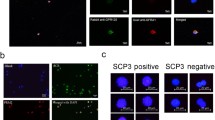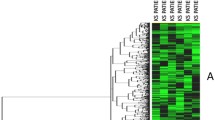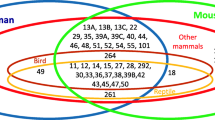Abstract
Spermatogenesis is an essential stage in the human reproductive process. In a previously study aiming to determine which genes might be involved in spermatogenesis, we compared the gene expression profiles of adult and fetal testes by hybridizing cDNA probes prepared from adult and fetal testes to membranes dotted with gene clones derived from a commercial human testis library. We identified 266 differentially expressed genes that showed higher expression levels in adult testes, indicating their potential roles in spermatogenesis. In the present study, we applied the same cDNA microarray technique to the analysis of gene expression in the spermatozoa of normal fertile men and found 149 genes that were expressed at higher levels in adult testis. A further study of five sperm motility-related genes selected from this profile by real-time PCR revealed that there was significant difference in the expression levels of two genes (TPX-1, testis-specific protein 1 and LDHC, lactate dehydrogenase C, transcript variant 1) between normal (n=29) and motility impaired (n=24) semen samples, indicating that these genes are involved in sperm function. Our results demonstrated that spermatogenesis-related gene profiling could help to assess sperm quality in humans, and further study of these genes will help us to elucidate the mechanisms involved in spermatogenesis and diseases relating to human infertility.




Similar content being viewed by others
References
Kramer JA, McCarrey JR, Djakiew D, Krawetz SA (2000) Human spermatogenesis as a model to examine gene potentiation. Mol Reprod Dev 56:254–258
Escalier D (2001) Impact of genetic engineering on the understanding of spermatogenesis. Hum Reprod Update 7:191–210
Burgess JK (2001) Gene expression studies using microarrays. Clin Exp Pharmacol Physiol 28:321–328
Murphy D (2002) Gene expression studies using microarrays: principles, problems, and prospects. Adv Physiol Educ 26:256–270
Cooke HJ, Hargreave T, Elliott DJ (1998) Understanding the genes involved in spermatogenesis: a progress report. Fertil Steril 69:989–995
Sha J, Zhou Z, Li J, Yin L, Yang H, Hu G, Luo M, Chan HC, Zhou K (2002) Identification of testis development and spermatogenesis-related genes in human and mouse testes using cDNA arrays. Mol Hum Reprod 8:511–517
Xiao J, Xu M, Li J, Chang Chan H, Lin M, Zhu H, Zhang W, Zhou Z, Zhao B, Sha J (2002) NYD-SP6, a novel gene potentially involved in regulating testicular development/spermatogenesis. Biochem Biophys Res Commun 291:101–110
Adams MD, Kerlavage AR, Fleischmann RD, Fuldner RA, Bult CJ, Lee NH, Kirkness EF, Weinstock KG, Gocayne JD, White O, et al (1995) Initial assessment of human gene diversity and expression patterns based upon 83 million nucleotides of cDNA sequence. Nature 377:3–174
O’Bryan MK, Sebire K, Meinhardt A, Edgar K, Keah HH, Hearn MT, De Kretser DM (2001). Tpx-1 is a component of the outer dense fibers and acrosome of rat spermatozoa. Mol Reprod Dev 58:116–125
Petersen C, Fuzesi L, Hoyer-Fender S (1999) Outer dense fibre proteins from human sperm tail: molecular cloning and expression analyses of two cDNA transcripts encoding proteins of approximately 70 kDa. Mol Hum Reprod 5:627–635
Kierszenbaum AL, Tres LL (2002) Bypassing natural sperm selection during fertilization: the azh mutant offspring experience and the alternative of spermiogenesis in vitro. Mol Cell Endocrinol 187:133–138
Turner RM, Eriksson RL, Gerton GL, Moss SB (1999) Relationship between sperm motility and the processing and tyrosine phosphorylation of two human sperm fibrous sheath proteins, pro-hAKAP82 and hAKAP82. Mol Hum Reprod 5:816–824
Zinkham WH (1972) A unique form of lactate dehydrogenase in human sperm: biological and clinical significance. Johns Hopkins Med J 130:1–10
Ikawa M, Nakanishi T, Yamada S, Wada I, Kominami K, Tanaka H, Nozaki M, Nishimune Y, Okabe M (2001) Calmegin is required for fertilin alpha/beta heterodimerization and sperm fertility. Dev Biol 240:254–261
Eddy EM, O’Brien DA (1998) Gene expression during mammalian meiosis. Curr Top Dev Biol 37:141–200
Eddy EM (2002) Male germ cell gene expression. Recent Prog Horm Res 57:103–128
Miller D (2000) Analysis and significance of messenger RNA in human ejaculated spermatozoa. Mol Reprod Dev 56:259–264
Hecht NB (1990) Regulation of ‘haploid expressed genes’ in male germ cells. J Reprod Fertil 88:679–693
Miller D (1997) RNA in the ejaculate spermatozoon: a window into molecular events in spermatogenesis and a record of the unusual requirements of haploid gene expression and post-meiotic equilibration. Mol Hum Reprod 3:669–676
Kumar G, Patel D, Naz RK (1993) c-MYC mRNA is present in human sperm cells. Cell Mol Biol Res 39:111–117
Miller D, Tang PZ, Skinner C, Lilford R (1994) Differential RNA fingerprinting as a tool in the analysis of spermatozoal gene expression. Hum Reprod 9:864–869
Yu Z, Guo R, Ge Y, Ma J, Guan J, Li S, Sun X, Xue S, Han D (2003) Gene expression profiles in different stages of mouse spermatogenic cells during spermatogenesis. Biol Reprod 69:37–47
Miller D, Briggs D, Snowden H, Hamlington J, Rollinson S, Lilford R, Krawetz SA (1999) A complex population of RNAs exists in human ejaculate spermatozoa: implications for understanding molecular aspects of spermiogenesis. Gene 17:385–392
Ostermeier GC, Dix DJ, Miller D, Khatri P, Krawetz SA (2002) Spermatozoal RNA profiles of normal fertile men. Lancet 360:772–777
Wykes SM, Visscher DW, Krawetz SA (1997) Haploid transcripts persist in mature human spermatozoa. Mol Hum Reprod 3:15–19
McCarrey JR, Thomas K (1987) Human testis-specific PGK gene lacks introns and possesses characteristics of a processed gene. Nature 326:501–505
Zhang LP, Stroud JC, Walter CA, Adrian GS, McCarrey JR (1998) A gene-specific promoter in transgenic mice directs testis-specific demethylation prior to transcriptional activation in vivo. Biol Reprod 59:284–292
McCarrey JR (1998) Spermatogenesis as a model system for developmental analysis of regulatory mechanisms associated with tissue-specific gene expression. Semin Cell Dev Biol 9:459–466
Turner RMO, Johnson LR, Haig-Ladewig L, Gerton GL, Moss SB (1998) An X-linked gene encodes a major human sperm fibrous sheath protein, hAKAP82: genomic organization, protein kinase A-RII binding, and distribution of the precursor in the sperm tail. J Biol Chem 273:32135–32141
Fraser LR, Hosseini R, Hanyalogou A, Talmor A, Dudley RK (1997) TCP-11, the product of a mouse t-complex gene, plays a role in stimulation of capacitation and inhibition of the spontaneous acrosome reaction. Mol Reprod Dev 48:375–382
Ma Y, Zhang S, Xia Q, Zhang G, Huang X, Huang M, Xiao C, Pan A, Sun Y, Lebo R, Milunsky A (2002) Molecular characterization of the TCP11 gene which is the human homologue of the mouse gene encoding the receptor of fertilization promoting peptide. Mol Hum Reprod 8:24–31
Ikawa M, Wada I, Kominami K, Watanabe D, Toshimori K, Nishimune Y, Okabe M (1997) The putative chaperone calmegin is required for sperm fertility. Nature 387:607–611
Nonoguchi K, Tokuchi H, Okuno H, Watanabe H, Egawa H, Saito K, Ogawa O, Fujita J (2001) Expression of Apg-1, a member of the Hsp110 family, in the human testis and sperm. Int J Urol 8:308–314
Hirotsune S, Fleck MW, Gambello MJ, Bix GJ, Chen A, Clark GD, Ledbetter DH, McBain CJ, Wynshaw-Boris A (1998) Graded reduction of Pafah1b1 (Lis1) activity results in neuronal migration defects and early embryonic lethality. Nat Genet 19:333–339
Cahana A, Reiner O (1999) LIS1 and platelet-activating factor acetylhydrolase (Ib) catalytic subunits, expression in the mouse oocyte and zygote. FEBS Lett 451:99–102
Schrader M, Muller-Tidow C, Ravnik S, Muller M, Schulze W, Diederichs S, Serve H, Miller K (2002) Cyclin A1 and gametogenesis in fertile and infertile patients: a potential new molecular diagnostic marker. Hum Reprod 17:2338–2343
Schrader M, Muller M, Schulze W, Heicappell R, Krause H, Straub B, Miller K (2002) Quantification of the expression level of the gene encoding the catalytic subunit of telomerase in testicular tissue specimens predicts successful sperm recovery. Hum Reprod 17:150–156
Meltzer SJ (2002) Application of cDNA microarrays to generate a molecular taxonomy capable of distinguishing between colon cancer and normal colon. Oncogene 21:4855–4862
Rickman DS, Bobek MP, Misek DE, Kuick R, Blaivas M, Kurnit DM, Taylor J, Hanash SM (2001) Distinctive molecular profiles of high-grade and low-grade gliomas based on oligonucleotide microarray analysis. Cancer Res 61:6885–6891
Donnelly ET, Lewis SE, McNally JA, Thompson W (1998) In vitro fertilization and pregnancy rates: the influence of sperm motility and morphology on IVF outcome. Fertil Steril 70:305–314
Hirano Y, Shibahara H, Obara H, Suzuki T, Takamizawa S, Yamaguchi C, et al (2001) Relationships between sperm motility characteristics assessed by the computer-aided sperm analysis (CASA) and fertilization rates in vitro. J Assist Reprod Genet 18:213–218
Amann RP (1989) Can the fertility potential of a seminal sample be predicted accurately? J Androl 10:89–98
Bongso TA, Ng SC, Mok H, Lim MN, Teo HL, Wong PC, Ratnam SS (1989) Effect of sperm motility on human in vitro fertilization. Arch Androl 22:185–190
Acknowledgements
This research was supported by grants from National 973 Plan of China (G1999055901), Nature Science Foundation of China (30170485) and the Foundation of Science and Technology of Jiangsu Province, China (BG2003028). We thank Dr. Aimin Tang for his critical review of the manuscript.
Author information
Authors and Affiliations
Corresponding author
Electronic Supplementary Material
Rights and permissions
About this article
Cite this article
Wang, H., Zhou, Z., Xu, M. et al. A spermatogenesis-related gene expression profile in human spermatozoa and its potential clinical applications. J Mol Med 82, 317–324 (2004). https://doi.org/10.1007/s00109-004-0526-3
Received:
Accepted:
Published:
Issue Date:
DOI: https://doi.org/10.1007/s00109-004-0526-3




